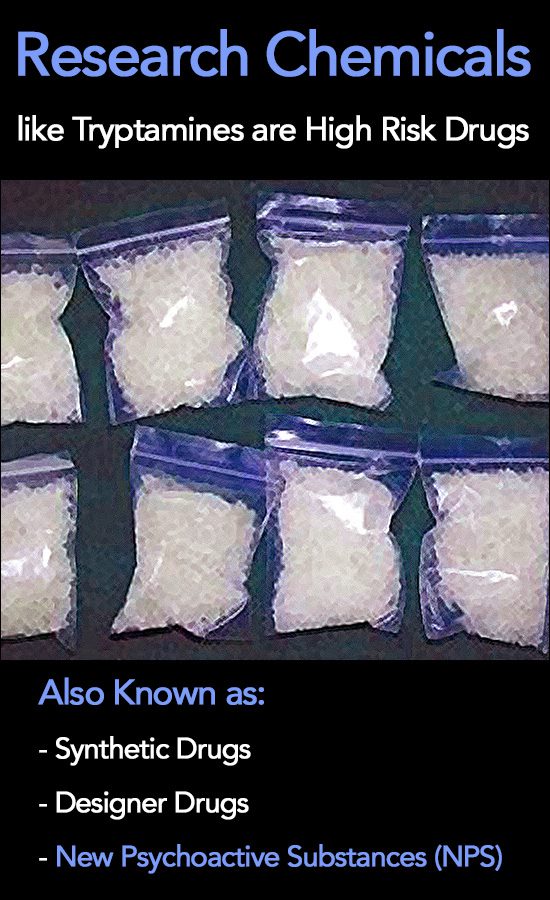Research Chemicals (RCs) are generally psychoactive substances, sometimes referred to as synthetic drugs, designer drugs, or New Psychoactive Substances (NPS).
These types of substances have gained the most traction among users who attend large music festivals and even some smaller club-type venues.
Unfortunately, they are also popular with college and high school kids who don’t have the experience with drugs to know what is real or fake. Sometimes the low price and easy availability make them attractive to teens and young adults.

These types of substances can skirt Federal Food and Drug Administration (FDA) and Drug Enforcement Agency (DEA) laws by slightly altering the chemical structure to stay within legal bounds, despite the fact that these substances are nearly identical to other illegal drugs.
To ensure that they continue to stay legal, manufacturers continually alter the chemical makeup of these drugs.
While that may temporarily keep law enforcement off their heels, recreational and habitual users of research chemicals rarely know what combination of substances they’re actually ingesting.
What are Research Chemicals?
Designed to resemble and often sold on the premise that the effects are similar to naturally occurring psychoactive substances like psilocybin mushrooms, peyote and others, Research Chemicals are usually synthetic knock-offs of other substances.
While many people buy research chemicals online thinking they are safe or harmless, they can be habit-forming and sometimes require addiction treatment. Depending on the type purchased and method of use, they have the potential to be extremely dangerous, causing users to become sick or possibly overdose.
The reference to New Psychoactive Substances does not mean that they are actually newly-created substances; instead, their “availability” to be purchased is new.
Though manufacturers, usually in illegal, underground laboratories in the United States, neighboring countries, or even overseas, slap the label “research chemicals” on packaging to avoid legal classification as a controlled substance, the marketing is typically aimed at recreational users.
Selling synthetic designer drugs might seem like exploiting a legal loophole for doing some “partying” and making some cash. But federal law enforcement agencies can make arrests and prosecute manufacturers for the possession and sale of drugs that are “substantially similar” to controlled substances.
According to Wired, an Arizona man found this out the hard way after being sentenced to 410 years.
What Are Some Common Types of Research Chemicals?
While the style of packaging may vary by the brand or type of substance, the words “for research purposes only,” “do not ingest” or “not for human consumption” is generally apparent somewhere on the container or packet.
Users may refer to these types of synthetics as “plant food” or “bath salts.”
In appearance, these types of drugs can be anything such as a white powder, crystalline texture, or capsules, and may be smoked, ingested or even injected.
Some Common Types of Research Chemicals Can Include the Following:
- Tryptamines such as LSD or psilocybin mushrooms
- Phenethylamines, including MDMA, MDA and ecstasy
- Synthetic opioids like fentanyl, U-47700, W-18
- Mephedrone aka Meow Meow
- Cathinones such as Flaka or Gravel
- Dissociatives like Methoxetamine and Ketamine
- Aminoindanes like Bath Salts
What are the Dangers of Using RCs or NPS Chemicals?
Put bluntly, most users of Research Chemicals have little to no idea what types of substances they are ingesting when taking these products, or the risks involved, especially when mixed with other substances such as alcohol, marijuana or other more “mainstream” drugs.
One study found that the recreational use of RC’s comes with the risk of nausea, vomiting, and diarrhea, as well far more serious problems like disorientation and “frightening hallucinations.”
These types of designer drugs are, in some cases, even more dangerous because if a person has a negative, potentially fatal reaction, first responders may not know what drugs they can use to counteract the overdose.
There is also very little evidence about how chronic or long-term use of RCs will affect a person’s mental and physical health.
Addiction Treatment for Research Chemicals or New Psychoactive Substances
While most Research Chemicals or New Psychoactive Substances aren’t necessarily addictive, especially when compared to drugs like heroin or opioids, they are still unsafe to use and can lead to other health problems.
Certainly, a consistent pattern of using these types of dangerous substances, along with other drugs or too much alcohol use, is a sign that a person may be struggling with substance abuse dependence or mental health issues.
Addiction treatment can be incredibly effective in helping an individual recover from physical and chemical dependence and address the underlying psychological patterns that lead to these problems.
Individualized and group counseling can be a great place to start in a recovery program. This is usually combined with approaches like cognitive behavioral therapy (CBT) and other addiction treatment modalities to help an individual get back on firm footing for a long and productive recovery.
Related:
The Dangers of Abusing Ketamine and Falling Into the K-Hole
GHB Addiction: Once an Anesthetic, Now a Club Drug of Abuse
What is the Difference Between Molly (MDMA) & Sally (MDA)?





